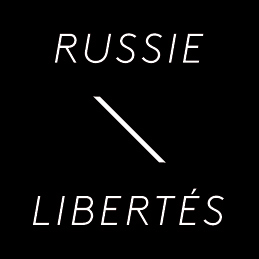Gazprom’s activity has a devastating impact on climate change, Baltic Sea nature and indigenous people
Energy and climate change specialists are no longer in consensus that gas is a genuine “bridge fuel” from coal to renewables. Methane leaks hugely contribute to global warming, and these leaks from all major fossil fuel companies during production and transportation are now seen as much higher than was thought in the last decade.
However, even if there is still some room for doubt about the damage from methane leaks from a regular western gas company, there is no doubt that Gazprom is one of the worst in terms of climate change among its global peers. Carbon Disclosure Project (CDP) in collaboration with the Climate Accountability conducted investigation of active fossil fuel producers. According to this investigation, Gazprom’s greenhouse gas emissions totaled 35,221 billion tons from 1988 to 2015. CDP shows that Gazprom is the second largest “producer” of greenhouse gases on the planet.
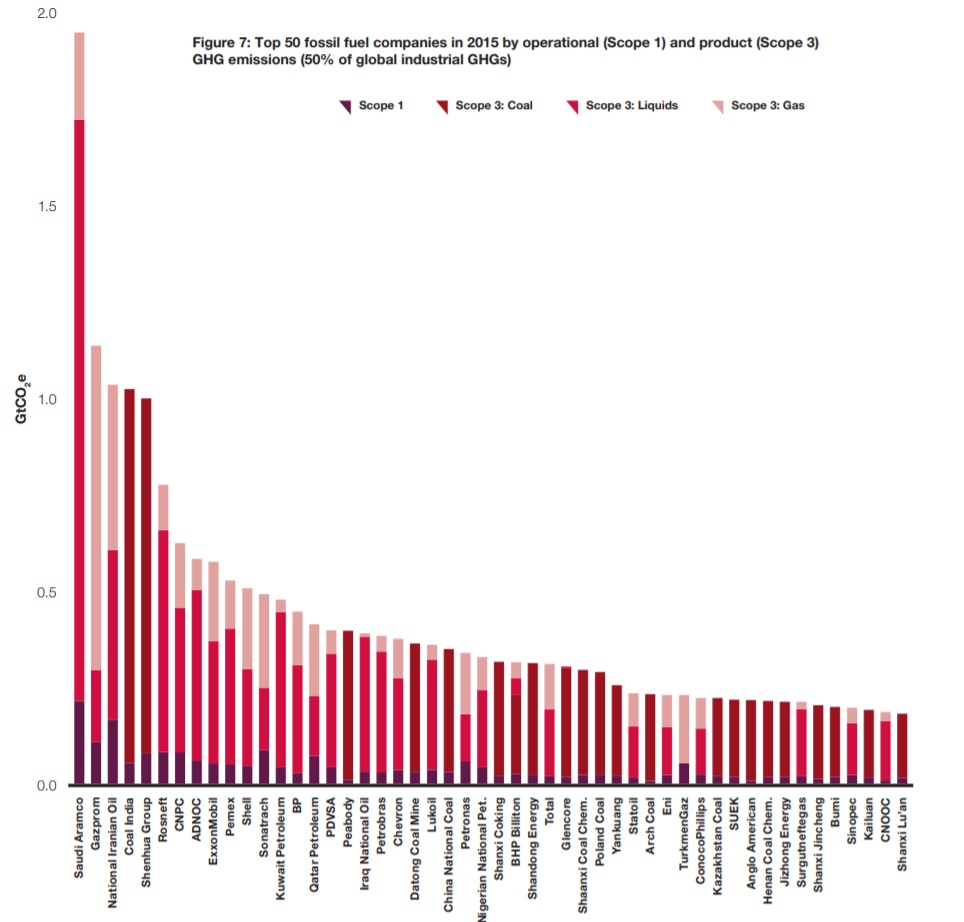
Source: CDP Carbon Majors Report 2017
Gazprom invests much less into low carbon investment compared to peers despite “green” rhetoric from its partners and lobbyists.
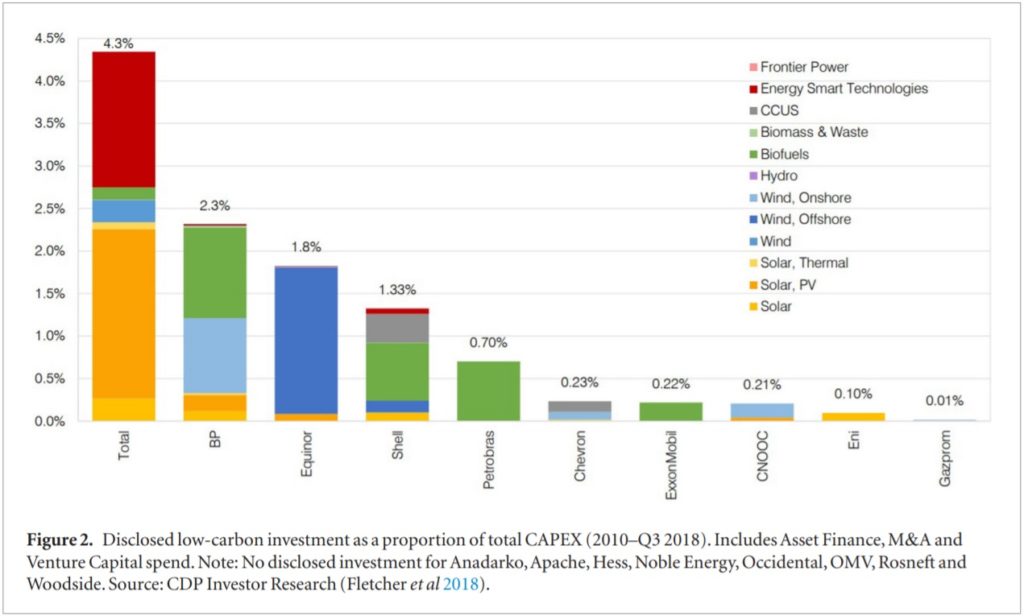
Source: Ensieh Shojaeddini et al 2019 Prog. Energy
May be Gazprom, a state-controlled monopoly, is just an aberration within Russia’s oil and gas sector? No, it’s a reflection of a consistent government policy of negligence to key issues surrounding climate change and Gazprom. According to the Global Gas Flaring Reduction (GGFR) program at the World Bank, for years Russia has remained a champion of wasteful and harmful flaring from oil and gas activity mainly – way bigger than any other comparable country. And this is despite almost 20 years of futile promises from the President of Russia Vladimir Putin and Gazprom to tackle the problem of massive gas flaring.
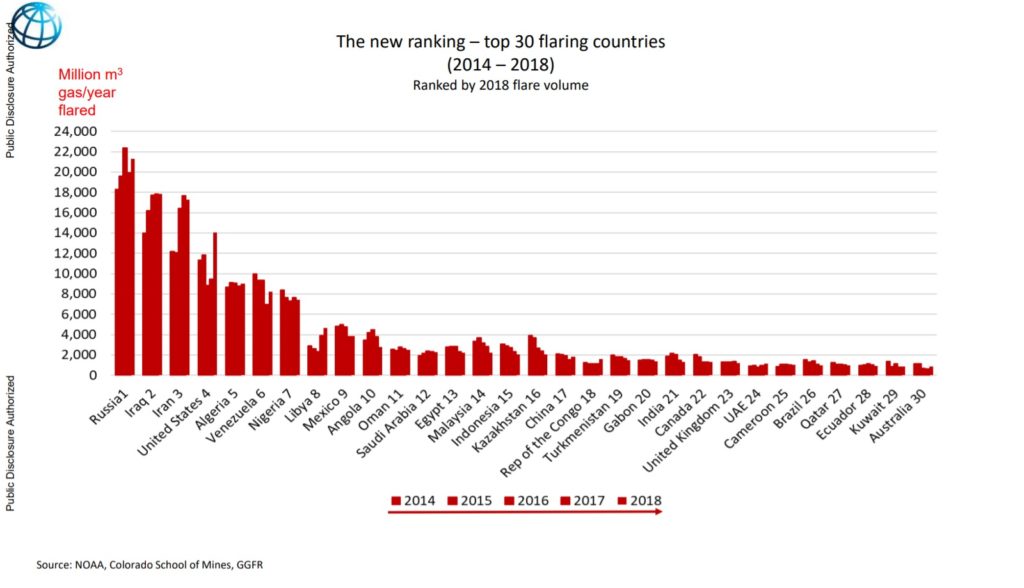
Source: NOAA, Colorado School of Mines, GGFR
Gazprom should be called on for its hypocrisy, as the monopoly prevents other Russian oil companies from reducing their flaring by blocking them out of the domestic gas transit system known as Unified Gas Supply System (UGSS). See study by Columbia University (Columbia Center of Sustainable Development, slide on page 13). So instead of saying NS2 will improve climate change situation, may be Gazprom should invest and allow much required third party access for otherwise flared gas inside Russia?
Nord Stream 2 is bad for Europe in terms of climate change, not just Russia. Experts point out that if gas transit through Ukraine is closed, then there is not enough available pipeline capacity from Germany in eastward direction to feed all necessary gas to Central and Eastern Europe, especially during peak times. This means that the energy deficit will have to be at least partially covered by dirty coal.
In fact, Mikhail Korchemkin from East European Gas Analysis suggests that the so-called “capacity optimization plan” of Gazprom puts at risk the reduction of greenhouse emissions in the EU. By the plan Gazprom means that after NS2 is launched, it will Liquidate most of pipeline capacity at the Russian-Ukrainian border effectively creating a deficit of peak gas in Central Europe. Renewable energy is supposed to be backed up by peak-load gas turbines, but without additional volumes of gas provided by the highly flexible capacity of the Ukrainian transit system, renewables would have to be combined with coal-firing plants throughout affected areas of Europe (for more on “optimization plan” see below).
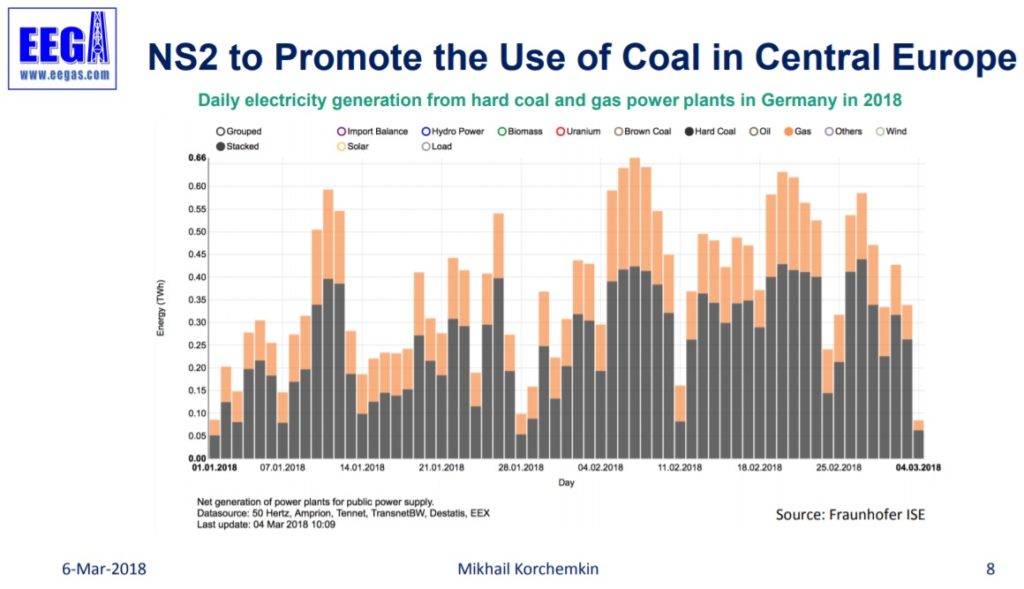
Source: East European Gas Analysis
In the Baltic Sea, the NS2 pipeline runs through marine protected areas of the Natura 2000 network. According to the Finnish Centre for Economic Development, Transport and the Environment, NS2 poses risks to the fragile eco-balance of the Baltic Sea, including Natura 2000 sites. This damage is not justifiable by public interest.
Greenpeace and other environmental groups say construction of Nord Stream 2 has been polluting Germany’s Baltic coast with toxic grease found on beaches and in the sea and disrupting the environment, damaging various forms of flora, fauna and marine life in the region. As a result of the construction of the pipeline along the bottom of the Baltic Sea outburst of 140kg of grease occurred, (grease was used to lubricate moving pieces on a dredger). NABU concluded that the pipeline is a disturbance to five Natura 2000 sites in coastal areas and the Exclusive Economic Zone (EEZ) in Germany.
A comprehensive study from 2017 by the World Wildlife Fund (WWF) and the German Nature and Biodiversity Conservation Union (NABU) detail damage caused by deforestation, sand extraction and lax species conservation regulations in the course of construction work in several countries because of NS2.
On the territory of Russia, NS2 gas pipeline passes through the high-value natural area called Kurgalsky Nature Reserve which has now become a place of environmental catastrophe because of Gazprom.
In preparation for this conference Evgeniya Chirikova, an environmental activist from Russia, made a special survey of violations that NS2 has inflicted on Kurgalsky reserve. According to her research and interviews with multiple environmental NGOs, the chosen pipeline route is extremely destructive for nature and violates multiple domestic and international laws.
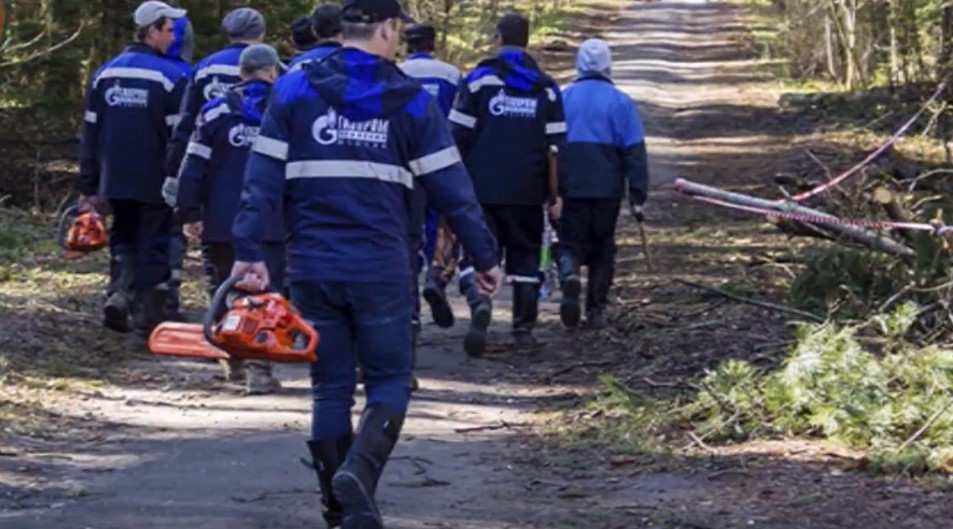
Source: Activatica.org
Dutch government, NGOs and media should note that the Nord Stream 2 AG company’s website contains a number of statements that can be safely called false or misleading.
In the section about Nord Stream 2 in Kurgalsky Reserve the site states, “Nord Stream 2 will be implemented in accordance with Russian and international legislation.” This statement is a lie, since the NS2 project violates several international conventions: the Ramsar Convention on Wetlands of International Importance, the Convention on the Conservation of Migratory Species of Wild Animals, and the Helsinki Convention on the Protection of the Marine Environment of the Baltic Sea Area. Additionally, construction of the Nord Stream 2 pipeline is in violation of the Russian Federal Laws “On Wildlife” and “On Specially Protected Natural Territories”.
Greenpeace Austria has received secret minutes of meetings between Russian government members and representatives of Nord Stream 2 AG and Gazprom from a former high-ranking official of the Russian Ministry of the Environment, which discussed the changes in environmental legislation or the boundaries of Kurgalsky nature reserve for the implementation of the Nord Stream 2 project. At the moment, it is impossible to assess the damage from changes in Russian legislation, since not only the Kurgalsky nature reserve, but also all other Russian reserves are under threat.
However, what is already known for certain is that species (plants, flowers, mosses, birds, lizards) which are listed in the Red Book of the Russian Federation and the Red Book of the Leningrad Region are found on the planned route and are now under threat of extinction. The construction of NS2 in the habitats of the white-tailed eagle in the immediate vicinity of the nest is a violation of the Federal Law “On Wildlife” and of the Federal Law “On Specially Protected Natural Territories”.
Experts of the Botanical Institute. V. L. Komarova of the Russian Academy of Sciences analyzed the results of transplanting of Red Book plants from the pipeline corridor. It turned out that in eight of the nine examined sites found the death of transplanted plants. At one of the sites where, according to the documentation, more than 11 thousand plants of Drosera intermedia were transplanted, botanists found “several tens of plants in an oppressed state”: “We can state the fact that more than 95% of plants died”. Instead of “Pulsatilla patens” at the site where, according to the report, Company “Ecoproject” (contractor of the project developer Nord Stream 2 AG) transferred plants, scientists found “hybrids of Pulsatilla pratensis and Pulsatilla patens”. “The hybrid is not included in the Red Book of the Leningrad Region and “was not subject to transplantation,” the conclusion says. “Hybrid plants are characterized by higher viability, which led to their good survival after transplantation.” Thus, it turns out that the NS2 campaign falsified data on the results of transplantation of rare Red Book plants in the pipeline corridor.
Important information about the significance of the Kurgalsky Nature Reserve is hidden in Environmental Impact Assessment reports of Nord Stream 2 AG, also known as Espoo (Espoo reports document potential transboundary impacts of the project on nature). The regime of the Kurgalsky reserve is not reflected in the Espoo materials and other materials justifying the choice of the pipeline route. The Espoo materials is in violation with multiple laws and regulations, both domestic and international such as Article 4 of the Convention on Environmental Impact Assessment in a Transboundary Context (the Espoo Convention), the Ramsar Convention on Wetlands. The Espoo materials present unreliable data regarding the choice of the route in consideration with conservation of marine mammals and birds.
In the “Environmental and social initiative strategies” section of their website, Nord Stream 2 AG says, “our environmental and social initiative strategies guarantee responsible implementation of the project in the most sustainable way.” This statement raises serious and reasonable doubts.
Independent experts from the Center for Expertise (ECOM), research entity for Saint Petersburg naturalists, did an assessment of the environmental impact of NS2 which they presented to the public in January 2018. After evaluating 138 volumes of materials on the NS2 project, ECOM concluded that the company simply skimps on the environmental safety of the project: in their opinion, the gas pipeline could have run through the Narva Bay bypassing the Kurgalsky reserve through micro-tunnelling, as was done in Germany, but then the project’s costs would have increased. The ecologists could not estimate the cost of the increase, but assumed it would be 0.5% of the project cost.
Double standards have been applied while deciding on the route of the pipeline in Germany and Russia. In Germany, where the value of the coastal territory is disproportionately smaller than the territory of the Kurgalsky reserve, Nord Stream 2 AG nevertheless considers it possible to use micro-tunneling method in the construction, justifying this by the advantages of this method. In Russia, under similar conditions and incomparably greater (albeit deliberately understated) value of the Kurgalsky reserve, the “traditional method of construction with an open trench with corridor width of 85 m” is adopted. This last method has major implications on wildlife in Kurgalsky.
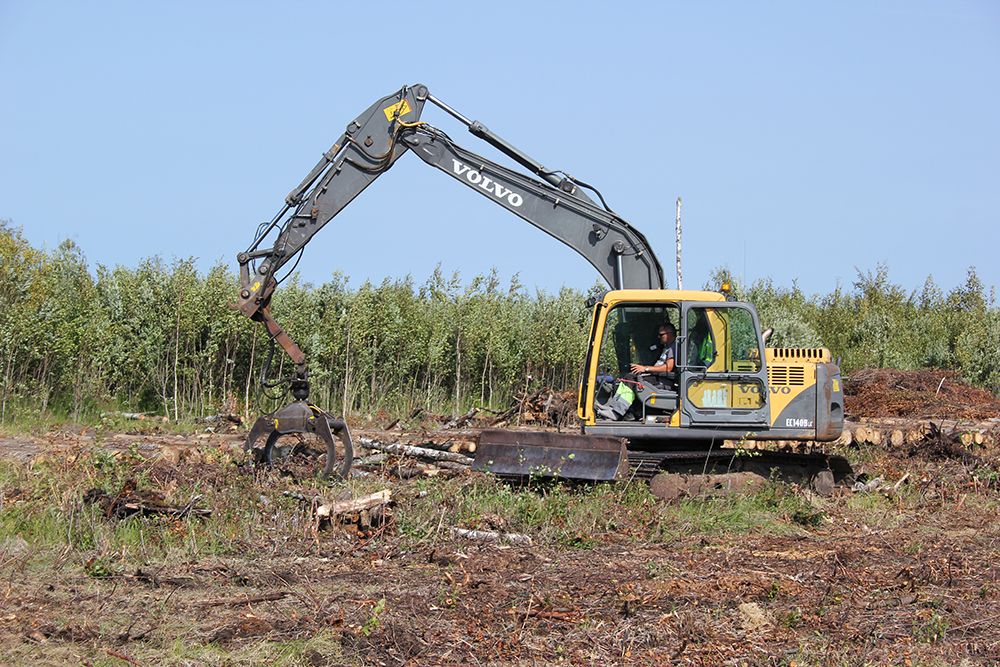
Source: Activatica.org
ECOM concluded that the project is inadmissible due to the inconsistency of documentation justifying the planned construction to the requirements established by Russian legislation, international conventions and the Constitution of the Russian Federation. Also, they concluded that the EIA materials contain intentional downgrading of the value of the Kurgalsky wildlife sanctuary as compared to the alternative route through the Soikino peninsula. Finally, there is no program of environmental monitoring or control in the course of the construction and exploitation on either sea or onshore segments.
Evgeniya Chirikova as well as many other activists that she has interviewed also believe that the violations that Gazprom has pushed through against Kurgalsky Nature Reserve has now set a new low precedent. Removal of domestic regulations and circumvention of existing international laws protecting this reserve can now be easily replicated by Gazprom elsewhere against natural reserves in Altay and other regions where the monopoly wants to build its massive trunk pipelines. The same goes for manipulation of public hearings which are supposed to be an integral part of any genuine due process but in reality, are carried out fraudulently by the monopoly.
Public meetings in in Kingisepp in Russia related to construction of NS2 were heavily manipulated. Contrary to what the Nord Stream 2 AG and local officials argue, residents that attended public meetings did not express support for the Nord Stream 2 project. Representatives of environmental NGOs warned about falsifications in the EIA documentation of the project – which is reflected in the minutes of the meeting.
Furthermore, when asked to come to Kingisepp for the meeting, some of the locals did not know the purpose of the meeting. Also, many local residents were not informed about the public meetings, so they could not join. Some residents in the Kurgalsky region identify themselves as indigenous people; Izhora, Ingermanlanders, and Vod. According to the ILO 169 standard these people fall under the protection of Free Prior and Informed Consent (FPIC). As these people have not been properly informed, nor consulted with, FPIC is not implemented. Residents of eighteen villages of Kingiseppsky district of the Leningrad region addressed the President of Russia. In their public letter they asked to stop NS2 pipeline and spare Kurgalsky reserve.
Dutch government sponsors various projects protecting indigenous people around the world, including in Russia. Kremlin, however, has recently increased its suppression of any genuine defense of the rights of indigenous people. People in Netherlands should be informed that Gazprom’s operations linked directly to NS2 destroy areas of indigenous people in Yamal. This is a huge topic hardly covered by western press and NGOs because Gazprom has created a no access regime to Yamal for activists and reporters. Gas for the Nord Stream 2 project will be produced on the territory of Yamal, inhabited by indigenous peoples, leading a nomadic lifestyle. In 2012, the first gas supplies were produced from the vast Bovanenkovo reserve, and billions of cubic meters of gas are now piped to Western Europe via Nord Stream 1. As a result of this exploitation, many indigenous inhabitants have had to relocate or leave the Yamal Peninsula for fear of being forced to live in permanent settlements. At the same time, Russian government is flooding the discussion around the rights of indigenous people with government-led fake NGOs (GONGOs) and uses mechanisms of monetary cooptation and intimidation to silence protests and dissent. More materials of what is really happening in Yamal will be presented at the conference.





